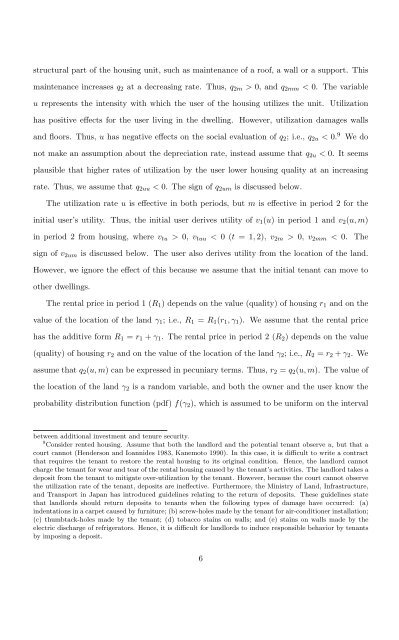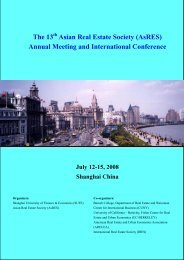You also want an ePaper? Increase the reach of your titles
YUMPU automatically turns print PDFs into web optimized ePapers that Google loves.
structural part of the housing unit, such as maintenance of a roof, a wall or a support. This<br />
maintenance increases q2 at a decreasing rate. Thus, q2m > 0, and q2mm < 0. The variable<br />
u represents the intensity with which the user of the housing utilizes the unit. Utilization<br />
has positive effects for the user living in the dwelling. However, utilization damages walls<br />
and floors. Thus, u has negative effects on the social evaluation of q2; i.e., q2u < 0. 9 We do<br />
not make an assumption about the depreciation rate, instead assume that q2u < 0. It seems<br />
plausible that higher rates of utilization by the user lower housing quality at an increasing<br />
rate. Thus, we assume that q2uu < 0. The sign of q2um is discussed below.<br />
The utilization rate u is effective in both periods, but m is effective in period 2 for the<br />
initial user’s utility. Thus, the initial user derives utility of v1(u) in period 1 and v2(u, m)<br />
in period 2 from housing, where vtu > 0, vtuu < 0 (t = 1, 2), v2m > 0, v2mm < 0. The<br />
sign of v2um is discussed below. The user also derives utility from the location of the land.<br />
However, we ignore the effect of this because we assume that the initial tenant can move to<br />
other dwellings.<br />
The rental price in period 1 (R1) depends on the value (quality) of housing r1 and on the<br />
value of the location of the land γ1; i.e., R1 = R1(r1, γ1). We assume that the rental price<br />
has the additive form R1 = r1 + γ1. The rental price in period 2 (R2) depends on the value<br />
(quality) of housing r2 and on the value of the location of the land γ2; i.e., R2 = r2 + γ2. We<br />
assume that q2(u, m) can be expressed in pecuniary terms. Thus, r2 = q2(u, m). The value of<br />
the location of the land γ2 is a random variable, and both the owner and the user know the<br />
probability distribution function (pdf) f(γ2), which is assumed to be uniform on the interval<br />
between additional investment and tenure security.<br />
9 Consider rented housing. Assume that both the landlord and the potential tenant observe u, but that a<br />
court cannot (Henderson and Ioannides 1983, Kanemoto 1990). In this case, it is difficult to write a contract<br />
that requires the tenant to restore the rental housing to its original condition. Hence, the landlord cannot<br />
charge the tenant for wear and tear of the rental housing caused by the tenant’s activities. The landlord takes a<br />
deposit from the tenant to mitigate over-utilization by the tenant. However, because the court cannot observe<br />
the utilization rate of the tenant, deposits are ineffective. Furthermore, the Ministry of Land, Infrastructure,<br />
and Transport in Japan has introduced guidelines relating to the return of deposits. These guidelines state<br />
that landlords should return deposits to tenants when the following types of damage have occurred: (a)<br />
indentations in a carpet caused by furniture; (b) screw-holes made by the tenant for air-conditioner installation;<br />
(c) thumbtack-holes made by the tenant; (d) tobacco stains on walls; and (e) stains on walls made by the<br />
electric discharge of refrigerators. Hence, it is difficult for landlords to induce responsible behavior by tenants<br />
by imposing a deposit.<br />
6



